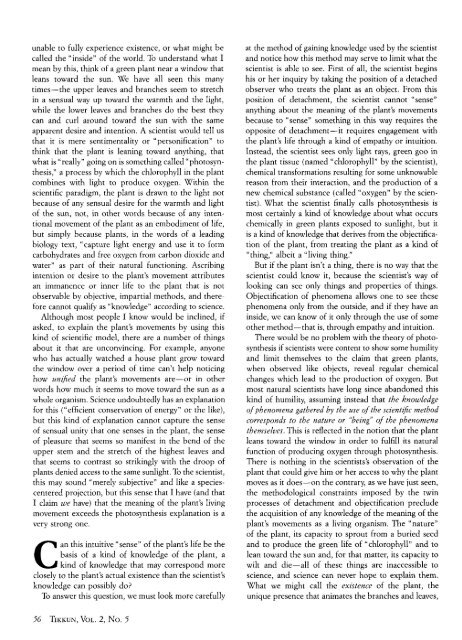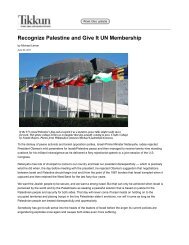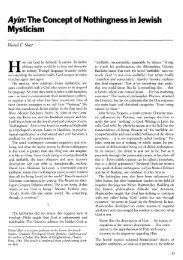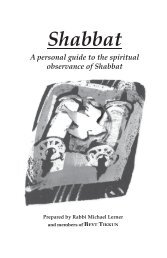Creationism and the Spirit of Nature - Tikkun Magazine
Creationism and the Spirit of Nature - Tikkun Magazine
Creationism and the Spirit of Nature - Tikkun Magazine
Create successful ePaper yourself
Turn your PDF publications into a flip-book with our unique Google optimized e-Paper software.
unable to fully experience existence, or what might be<br />
called <strong>the</strong> "inside" <strong>of</strong> <strong>the</strong> world. To underst<strong>and</strong> what I<br />
mean by this, think <strong>of</strong> a green plant near a window that<br />
leans toward <strong>the</strong> sun. We have all seen this many<br />
times-<strong>the</strong> upper leaves <strong>and</strong> branches seem to stretch<br />
in a sensual way up toward <strong>the</strong> warmth <strong>and</strong> <strong>the</strong> light,<br />
while <strong>the</strong> lower leaves <strong>and</strong> branches do <strong>the</strong> best <strong>the</strong>y<br />
can <strong>and</strong> curl around toward <strong>the</strong> sun with <strong>the</strong> same<br />
apparent desire <strong>and</strong> intention. A scientist would tell us<br />
that it is mere sentimentality or "personification" to<br />
think that <strong>the</strong> plant is leaning toward anything, that<br />
what is "reallyn going on is something called "photosyn-<br />
<strong>the</strong>sis," a process by which <strong>the</strong> chlorophyll in <strong>the</strong> plant<br />
combines with light to produce oxygen. Within <strong>the</strong><br />
scientific paradigm, <strong>the</strong> plant is drawn to <strong>the</strong> light not<br />
because <strong>of</strong> any sensual desire for <strong>the</strong> warmth <strong>and</strong> light<br />
<strong>of</strong> <strong>the</strong> sun, not, in o<strong>the</strong>r words because <strong>of</strong> any inten-<br />
tional movement <strong>of</strong> <strong>the</strong> plant as an embodiment <strong>of</strong> life,<br />
but simply because plants, in <strong>the</strong> words <strong>of</strong> a leading<br />
biology text, "capture light energy <strong>and</strong> use it to form<br />
carbohydrates <strong>and</strong> free oxygen from carbon dioxide <strong>and</strong><br />
water" as part <strong>of</strong> <strong>the</strong>ir natural functioning. Ascribing<br />
intention or desire to <strong>the</strong> plant's movement attributes<br />
an immanence or inner life to <strong>the</strong> plant that is not<br />
observable by objective, impartial methods, <strong>and</strong> <strong>the</strong>re-<br />
fore cannot qualify as "knowledge" according to science.<br />
Although most people I know would be inclined, if<br />
asked, to explain <strong>the</strong> plant's movements by using this<br />
kind <strong>of</strong> scientific model, <strong>the</strong>re are a number <strong>of</strong> things<br />
about it that are unconvincing. For example, anyone<br />
who has actually watched a house plant grow toward<br />
<strong>the</strong> window over a period <strong>of</strong> time can't help noticing<br />
how unified <strong>the</strong> plant's movements are-or in o<strong>the</strong>r<br />
words how much it seems to move toward <strong>the</strong> sun as a<br />
whole organism. Science undoubtedly has an explanation<br />
for this ("efficient conservation <strong>of</strong> energy" or <strong>the</strong> like),<br />
but this kind <strong>of</strong> explanation cannot capture <strong>the</strong> sense<br />
<strong>of</strong> sensual unity that one senses in <strong>the</strong> plant, <strong>the</strong> sense<br />
<strong>of</strong> pleasure that seems so manifest in <strong>the</strong> bend <strong>of</strong> <strong>the</strong><br />
upper stem <strong>and</strong> <strong>the</strong> stretch <strong>of</strong> <strong>the</strong> highest leaves <strong>and</strong><br />
that seems to contrast so strikingly with <strong>the</strong> droop <strong>of</strong><br />
plants denied access to <strong>the</strong> same sunlight. To <strong>the</strong> scientist,<br />
this may sound "merely subjective" <strong>and</strong> like a species-<br />
centered projection, but this sense that I have (<strong>and</strong> that<br />
I claim we have) that <strong>the</strong> meaning <strong>of</strong> <strong>the</strong> plant's living<br />
movement exceeds <strong>the</strong> photosyn<strong>the</strong>sis explanation is a<br />
very strong one.<br />
an this intuitive "sense" <strong>of</strong> <strong>the</strong> plant's life be <strong>the</strong><br />
basis <strong>of</strong> a kind <strong>of</strong> knowledge <strong>of</strong> <strong>the</strong> plant, a<br />
kind <strong>of</strong> knowledge that may correspond more<br />
closely to <strong>the</strong> plant's actual existence than <strong>the</strong> scientist's<br />
knowledge can possibly do?<br />
To answer this question, we must look more carefully<br />
56 TIKKUN, VOL. 2, No. 5<br />
at <strong>the</strong> method <strong>of</strong> gaining knowledge used by <strong>the</strong> scientist<br />
<strong>and</strong> notice how this method may serve to limit what <strong>the</strong><br />
scientist is able to see. First <strong>of</strong> all, <strong>the</strong> scientist begins<br />
his or her inquiry by taking <strong>the</strong> position <strong>of</strong> a detached<br />
observer who treats <strong>the</strong> plant as an object. From this<br />
position <strong>of</strong> detachment, <strong>the</strong> scientist cannot "sense"<br />
anything about <strong>the</strong> meaning <strong>of</strong> <strong>the</strong> plant's movements<br />
because to "sense" something in this way requires <strong>the</strong><br />
opposite <strong>of</strong> detachment-it requires engagement with<br />
<strong>the</strong> plant's life through a kind <strong>of</strong> empathy or intuition.<br />
Instead, <strong>the</strong> scientist sees only light rays, green goo in<br />
<strong>the</strong> plant tissue (named "chlorophyll" by <strong>the</strong> scientist),<br />
chemical transformations resulting for some unknowable<br />
reason from <strong>the</strong>ir interaction, <strong>and</strong> <strong>the</strong> production <strong>of</strong> a<br />
new chemical substance (called "oxygen" by <strong>the</strong> scien-<br />
tist). What <strong>the</strong> scientist finally calls photosyn<strong>the</strong>sis is<br />
most certainly a kind <strong>of</strong> knowledge about what occurs<br />
chemically in green plants exposed to sunlight, but it<br />
is a kind <strong>of</strong> knowledge that derives from <strong>the</strong> objectifica-<br />
tion <strong>of</strong> <strong>the</strong> plant, from treating <strong>the</strong> plant as a kind <strong>of</strong><br />
"thing," albeit a "living thing."<br />
But if <strong>the</strong> plant isn't a thing, <strong>the</strong>re is no way that <strong>the</strong><br />
scientist could know it, because <strong>the</strong> scientist's way <strong>of</strong><br />
looking can see only things <strong>and</strong> properties <strong>of</strong> things.<br />
Objectification <strong>of</strong> phenomena allows one to see <strong>the</strong>se<br />
phenomena only from <strong>the</strong> outside, <strong>and</strong> if <strong>the</strong>y have an<br />
inside, we can know <strong>of</strong> it only through <strong>the</strong> use <strong>of</strong> some<br />
o<strong>the</strong>r method-that is, through empathy <strong>and</strong> intuition.<br />
There would be no problem with <strong>the</strong> <strong>the</strong>ory <strong>of</strong> photo-<br />
syn<strong>the</strong>sis if scientists were content to show some humility<br />
<strong>and</strong> limit <strong>the</strong>mselves to <strong>the</strong> claim that green plants,<br />
when observed like objects, reveal regular chemical<br />
changes which lead to <strong>the</strong> production <strong>of</strong> oxygen. But<br />
most natural scientists have long since ab<strong>and</strong>oned this<br />
kind <strong>of</strong> humility, assuming instead that <strong>the</strong> knowledge<br />
<strong>of</strong> phenomena ga<strong>the</strong>red by <strong>the</strong> use <strong>of</strong> <strong>the</strong> scientific method<br />
corresponds to <strong>the</strong> nature or "being" <strong>of</strong> <strong>the</strong> phenomena<br />
<strong>the</strong>mselves. This is reflected in <strong>the</strong> notion that <strong>the</strong> plant<br />
leans toward <strong>the</strong> window in order to fulfill its natural<br />
function <strong>of</strong> producing oxygen through photosyn<strong>the</strong>sis.<br />
There is nothing in <strong>the</strong> scientists's observation <strong>of</strong> <strong>the</strong><br />
plant that could give him or her access to why <strong>the</strong> plant<br />
moves as it does-on <strong>the</strong> contrary, as we have just seen,<br />
<strong>the</strong> methodological constraints imposed by <strong>the</strong> twin<br />
processes <strong>of</strong> detachment <strong>and</strong> objectification preclude<br />
<strong>the</strong> acquisition <strong>of</strong> any knowledge <strong>of</strong> <strong>the</strong> meaning <strong>of</strong> <strong>the</strong><br />
plant's movements as a living organism. The "nature"<br />
<strong>of</strong> <strong>the</strong> plant, its capacity to sprout from a buried seed<br />
<strong>and</strong> to produce <strong>the</strong> green life <strong>of</strong> "chlorophyll" <strong>and</strong> to<br />
lean toward <strong>the</strong> sun <strong>and</strong>, for that matter, its capacity to<br />
wilt <strong>and</strong> die-all <strong>of</strong> <strong>the</strong>se things are inaccessible to<br />
science, <strong>and</strong> science can never hope to explain <strong>the</strong>m.<br />
What we might call <strong>the</strong> existence <strong>of</strong> <strong>the</strong> plant, <strong>the</strong><br />
unique presence that animates <strong>the</strong> branches <strong>and</strong> leaves,








